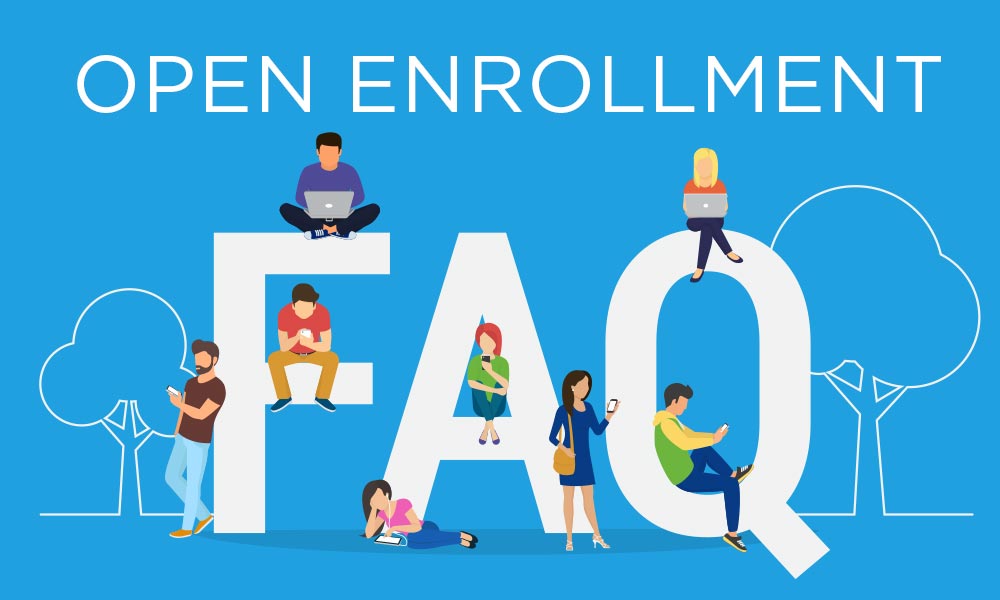1. What is open enrollment?
The open enrollment period is usually announced by the company once a year, during which time all eligible employees may enroll or re-enroll in their group benefits for the upcoming plan year. Employees can also make changes to their benefits, such as adding or deleting a dependent, upgrading to a plan with a lower deductible, adding supplemental benefits, or switching plans all together.
2. When am I eligible to enroll?
There are generally three times to enroll in company-sponsored benefits:
- When you get a new job where benefits are offered.
- During open enrollment, which usually happens one time per year.
- For a qualifying life event.
3. What is a qualifying life event (QLE)?
A qualifying life event may include a loss of benefits due to a job change or termination, the birth of death of a dependent, the adoption of a child, a divorce or marriage, becoming a US citizen, and moving to a new state that doesn’t offer your current plan.



4. Can I add family members to my benefits? —If so, how?
You may add dependents at your new hire enrollment, open enrollment or if you have a qualifying life event.
5. Am I required to sign up for health insurance?
No, you are not required to sign up for health insurance through your employer. You will be asked to waive coverage.
6. How much does health care/benefits cost?
Your company will provide you with a health care benefits guide. You can ask your HR professional for this guide and ask the professional to explain it to you.
7. Who selects my health insurance plan – me or my employer?
You will select you plan from the plans available through your employer.
8. What happens to my coverage if I leave the company?
Your coverage will usually terminate at the end of the month or on the date or the termination, depending how the plan is set up with your company. COBRA stands for Consolidated Omnibus Budget Reconciliation Act, and it provides the right for you to pay for continued coverage in a group health plan for at least 18 months but may extend up to 36 months if you have a second “qualifying event.” COBRA is required to be offered by a company with more than 20 employees. If you are a part of a company with fewer than 20 employees, there are oftentimes states that offer COBRA coverage, but normally at a reduced duration of time.
9. If I work less than full time, can I still get benefits through my employer(s)?
Most benefits plans will detail the eligibility requirements to participate in the plan, including employee classification (full-time, part-time, regular, temporary, etc.) and/or numbers of hours worked per week or month. Once these classifications change for a covered employee, his or her eligibility will need to be reassessed.
The Patient Protection and Affordable Care Act requires large employers to offer employees who work 30 or more hours per week health insurance benefits to avoid employer penalties, and there are different options for employers to measure the 30-hours-per-week threshold when an employee’s hours vary if the company has less then 50 employees.
Part-time employees may receive benefits, but it’s usually at the discretion of their employers. As long as they follow all minimum federal, state and local requirements, businesses have the freedom to dictate the terms of their benefits packages and who is or isn’t eligible.
10. Who qualifies as an eligible dependent?
Generally, family members qualify for coverage if they meet the specific criteria and definitions in the health plan contract. Typically, these family members include:
- Legal spouse
- Biological children and stepchildren
- Legally adopted children and children placed with you or your covered spouse for adoption
- Children for whom you or your spouse have been appointed legal guardian
- Foster children placed with you or your covered spouse
- Financially dependent grandchildren who live with you or your covered spouse continuously from birth
- Children allowed to obtain health coverage by a Qualified Medical Child Support Order
- Disabled dependent children older than age 26 who meet specific criteria
- A domestic partner of an unmarried contract holder
- Children of the domestic partner
You can include eligible children on your plan until they reach age 26. Your health plan will discontinue coverage on your children’s 26th birthday.
You can add new family members to your plan in special cases:
- Newborn baby: Add within 60 days of birth
- Adopted child: Add within 60 days of placement
- New spouse: Add within 60 days of marriage
- Job loss: Add a spouse or child (up to age 26) within 60 days of losing employer coverage
- Dependent child, older than age 26 who is disabled

11. What is the difference between an HRA, HSA and FSA?
A health savings account (HSA) is a bank account you own to pay for eligible health care expenses, or you can use it to save toward retirement. An HSA is offered with a qualified high-deductible health plan (HDHP) which typically has lower premiums/plan contributions and higher deductibles than a traditional health plan. If you have a health plan through your employer, the account is opened through the HSA provider chosen by your employer. You, your employer, and others can put money into your HSA up to a certain yearly limit set by the IRS guidelines.
A health reimbursement account (HRA) is a fund of money in an account that your employer owns and contributes to. HRAs are only available to employees who receive health care coverage from an employer.
A flexible spending account (FSA) is a spending account for different kinds of eligible expenses. There are three kinds of FSAs that may be available if you choose your own individual and family plan, or one through your employer:
- Health Care FSAs are for eligible medical expenses not covered by your health plan.
- Dependent Care FSAs cover eligible dependent care services for dependents (age 12 and under or disabled of any age).
- Limited-Purpose FSAs cover eligible dental and vision expenses if you are enrolled in a high-deductible health plan and have an HSA.
12. What is the difference between a PPO, HMO, and an HDHP?
The difference between a PPO, HMO, and an HDHP in simple terms is the deductible, out of pocket costs, and in-network doctors within each health plan.
PPO: The plan with the most freedom
A Preferred Provider Organization (PPO) has higher premiums than an HMO or POS. This plan lets you see specialists and out-of-network doctors without a referral, though out-of-network providers will cost you more. Copays and coinsurance for in-network doctors are low. If you know you’ll need more health care in the coming year and you can afford higher premiums, but don’t want to have to get a referral, a PPO is a good choice.
HMO: A budget-friendly plan
A Health Maintenance Organization (HMO) plan is one of the most affordable types of health insurance. It may have coinsurance, but usually has lower premiums and deductibles. It also often has fixed copays for doctor visits. It’s a good choice if you’re on a tight budget and don’t have many health issues.
HMOs require you to use doctors and hospitals in the HMO network, and you need to choose a primary care physician (PCP). This is the person you’ll see for regular checkups. Your PCP will need to give you a referral before you can see any specialist, like a dermatologist. Basically, you sacrifice flexibility for lower upfront costs with this plan.
HDHP with HSA: Offset out-of-pocket costs with a health savings account
A High Deductible Health Plan (HDHP) has low premiums but higher upfront out-of-pocket costs. Employers often pair an HDHP with a Health Savings Account (HSA) to help cover some, or all your deductible. The size of the deductible and HSA attached to it is the critical piece of a HDHP plan. You can deposit pre-tax dollars in your account to cover medical expenses, saving you about 30 percent. Even if you haven’t met your deductible, depending on your age, the plan may cover services such as mammograms, colonoscopies, annual well visits and vaccines at no extra charge.
An HDHP can be an HMO, POS, PPO, or EPO. People who are managing a health condition but on a tight budget may find an HDHP saves them money in the long run. Or someone who is healthy and doesn’t expect to utilize many health care services can take advantage of the cheapest premium.
13. What is the process for filing a claim, appeal, or reimbursement?
1. Claim form
Your insurance company has a health insurance claim form on their website. This will be a special claim form specific to your health plan. They’ll probably have a way to file the claim online, which is nice, but you should also be prepared to print the claim form and mail it in. Here are some things you may need to include on the form:
- Your insurance policy number, member number or group plan number
- The name of the patient receiving medical treatment (you, your spouse, your child or anyone covered under your plan)
- Whether or not you have dual coverage or coinsurance
- The reason for the treatment (like an injury, illness, or preventive care)
If you get into an accident at work and workers’ compensation covers it, you may need to fill out lots of special paperwork and go through a different insurance company than your normal health insurance company. You’ll want to talk to your HR representative or consult an attorney who specializes in workers’ compensation. This is also true if you get hurt in an auto accident or because of someone else’s negligence (like if you slip and fall on a wet surface inside of a business). These claims can get really complicated, and it’s good to have someone in your corner.
2. An itemized bill and receipts
This is important as you absolutely must get an itemized bill from your provider. It should detail every service your doctor provided and include things like:
- Examinations
- Lab tests like blood work or urine tests
- Radiology exams like X-rays, MRIs and CT scans
- Medications dispensed
- Surgery
- Cardiovascular tests like EKGs and echocardiograms
- Durable medical equipment like crutches or braces
3. Copies of everything
Make a copy of every single document you receive and put it into a file specifically marked for your claim. Keep everything in one place so you can easily find anything you may need later. Insurance claim forms sometimes get denied or lost, and they’re subject to all kinds of shenanigans. Being able to refer to your paperwork quickly and easily is a lifesaver.
Once you have all the paperwork needed, it’s time to file the claim. Most of the time, you can do this online. But sometimes you may have to submit a claim form by mail. Contact your insurance company. They should be able to walk you through the submission process.
14. What’s the difference between ‘in-network’ and ‘out-of-network’ care?
“In-network” care have contracted with your insurance company to accept certain negotiated rates. When a doctor, hospital, or other provider accepts your health insurance plan, that is in-network. “Out-of-network” care have not agreed to the discounted rates. If you go to a doctor or care provider who doesn’t take the plan, it is “out-of-network”. Typically, you will pay less going “in-network”.\
15. How can I find providers in my network?
To find providers in your network, first call your insurance company/state Medicaid and CHIP programs. Check their website for network providers for the plans that are being offered. Check your employee handbook to find doctors in your network who take your specific health coverage. You can also call your agent in case you don’t have any luck with calling the insurance company, checking the website, or checking the employee handbook.
16. Do I need dental, vision or other coverage?
Technically, no, you don’t need dental, vision or other coverages. However, dental and vision can be essential to your overall wellbeing. Early stages of many serious conditions can be detected through eye exams or oral exams.
17. Is healthcare taxable income?
In most cases, health benefits through your employer are not considered taxable income. Since employers pick up a percentage of the cost for these plans for their employees, the coverage is not subject to Social Security, Medicare, or federal unemployment taxes, or federal income withholding.
When you purchase health benefits through the open marketplace, they can be considered taxable income.
18. How can I choose between employer benefits and marketplace benefits?
When shopping around for health insurance coverage, carefully weigh the benefits and drawbacks of the plans offered by your employer and those available through other channels – such as the marketplace. Most experts advise to see what plans are offering and the rates through the health insurance marketplace before open enrollment periods, which can arm consumers with more information. In most cases, the group benefit plans will be three-tier, meaning you will be able to choose the deductible and out of pocket maximums that your budget will allow, along with the plan deductibles and coverage limits for yourself and dependents.
Here are some tips:
- Choose the plan that offers the greatest amount of coverage, with the lowest annual deductible, and the lowest monthly premium that you must pay.
- Keep in mind that if you buy your health insurance through the marketplace, you are doing so with earnings that have been taxed.
- If you buy your group health insurance plan through your employer, the deductions are taken pre-tax, which means your share is a bit smaller.
19. How can I know what kind of employee benefits I need?
This is an individual question, based on your unique needs and lifestyle. Each person is responsible for his or her own well-being, except for minor children who need their parents to provide for them. To best answer this question for yourself, determine what health services you are likely to participate in the coming year. You can look back to the past, your health history, your age-related concerns for screenings you may need, and any current medical care you receive. You will be looking at other factors too, such as what your budget allows in terms of monthly premiums and out of pocket costs.
If you have any special health goals to reach this year, you may want to choose a plan that includes access to discounts for weight loss support, fitness benefits, or programs to stop smoking. Then there are the legal requirements. You’ll need a health care plan that meets ACA minimum requirements.
20. If I get new benefits, do I have to switch health care providers?
This is a common worry among working people, because they are generally associated with a favorite physician or hospital group. The good news is that most insurance carriers work with large networks of healthcare providers in every state and region. Therefore, the health care plan that enabled you to visit a certain doctor or hospital may end, but your new coverage will allow you to continue that same care.
A good way to find out before you enroll in a specific plan is to visit the administrator’s website and do a quick look-up for your health care providers. You can also call your provider directly and ask if they accept the insurance plans that you are being offered at work. In most cases, they will accept your new insurance with no problems at all.

21. What is short term disability?
Short-term disability benefits are designed to protect you if you cannot perform your regular occupation for a short period of time. Short-term disability insurance is usually purchased as an employee benefit through your employer. Many employers offer a self-funded short-term disability plan where a third party administers the plan.
22. What is long term disability?
Long-term disability is an insurance plan that often works in tandem with short-term disability to provide income for long-term illnesses and injuries. Once short-term disability benefits are exhausted, a long-term disability policy continues to provide the employee with some income until they can return to work.
23. What is life insurance offered through an employer?
Life insurance offered through your employer is meant to provide a benefit to a designated “beneficiary” in the case of your death. Life insurance offered through your employer is typically term life insurance, not permanent. You should remember that you may have a gap in coverage if you leave your employer or retire. Term life insurance doesn’t build cash value like permanent life insurance products.
24. What is a 401K?
A 401(k) is a defined contribution retirement plan offered by an employer to their employees. The employee decides how much they want to contribute to their account. Employers can make contributions to the account as well, up to dollar limits set by the IRS. Contributions are typically pre-tax although employers can add a Roth feature, that allows employees to contribute after-tax funds to the account. Pre-tax contributions grow tax deferred, and Roth (After-tax contributions) grow tax free. Defined contribution plans were established as an alternative to Pension Plans, which are defined benefit plans. There are other savings vehicles that are similar to 401Ks that are named something different like Simple IRA and 403b. They correspond with the entity type of the company.
25. What is a 401K match?
Money your employer contributes to your 401(k) account. For each dollar you save, your employer will wholly or partially match your contribution up to a certain percentage of your salary. The Employer match is made with pre-tax dollars even if contribute to the Roth 401(k). Employer matching is a benefit that significantly boosts your 401(k)-retirement savings over the long term.
26. When do I enroll in a 401K?
You will become eligible to make 401(k) contributions and voluntary contributions and receive safe harbor matching contributions on the first day of the calendar month, coincident with or next following the date you attain age 21 and you complete 6 months of service, measured from your date of hire, provided that you are an eligible employee at the end of that period.
27. What is workers’ compensation?
Workers’ compensation is a government-mandated program that provides benefits to workers who are injured or fall ill on the job because of the job itself. Workers’ compensation functions as a disability insurance program for workers, providing cash benefits, health benefits or both to workers if they become injured on the job.
28. How do I know what to do in case of an injury on the job?
If you are injured on the job, you need to notify your immediate supervisor immediately. Your supervisor will determine if first aid is required. Then the following steps occur:
- Supervisor will notify your emergency contact if needed.
- Supervisor will take action to make sure the area where incident occurred is safe and secure.
- Your supervisor will meet with you to complete the accident report, which involves, stating the date of injury, place where it occurred (including address), a description of the injury or illness, date employer made aware, any other required information.
- Witnesses will be interviewed and give a statement if applicable.
- You will be informed of the claims process:
- You will be given a date that the accident report is due.
- You will select a physical from the panel of physicians given by the workers compensation program.
- You will fill out a claim form to cover medical expenses from the workers’ compensation policy.
- You will fill out a claim form to cover compensation benefits if the employee cannot work due to injury or illness.
- Family Medical Lead Act would provide 12 weeks of unpaid time off that could work in conjunction with the workers compensation claim if the company qualifies.
- A report will be filed with the workers compensation carrier by the company.
- The company will forward any necessary documentation: medical documents, wage reports, lost workdays, etc.
- The company will work with the employee to establish a timeline for the return to work.
